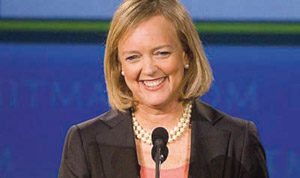 HP's Q3 saw top-line revenue growth year-over-year, but this was driven by growth in PCs, helped by XP refresh. Revenue was $27.6bn, up 1% yr/yr. Software, storage and enterprise services didn't do so well in the mix, and this affected the overall margin.
HP's Q3 saw top-line revenue growth year-over-year, but this was driven by growth in PCs, helped by XP refresh. Revenue was $27.6bn, up 1% yr/yr. Software, storage and enterprise services didn't do so well in the mix, and this affected the overall margin. HP's Q3 saw top-line revenue growth year-over-year, but this was driven by growth in PCs, helped by XP refresh. Revenue was $27.6bn, up 1% yr/yr. Software, storage and enterprise services didn't do so well in the mix, and this affected the overall margin. Enterprise services remains weak, falling 6% to $5.6bn after dropping 7% in Q2; software fell -5% to $959m, worse than Q2's flat growth. Printers were down -4% to $5.6bn, an even decline with Q2. Financial services -3% to $855m, after dropping 2% in Q2
 CEO Meg Whitman: “As I said many times before, turnarounds are not linear and we face some tough comparisons in the fourth quarter, but overall I continue to be very encouraged by the progress we're making. Overall, results in Q3 were driven by good performance in personal systems, growth in industry standard servers and networking as well as disciplined cost management across all of our businesses.”
CEO Meg Whitman: “As I said many times before, turnarounds are not linear and we face some tough comparisons in the fourth quarter, but overall I continue to be very encouraged by the progress we're making. Overall, results in Q3 were driven by good performance in personal systems, growth in industry standard servers and networking as well as disciplined cost management across all of our businesses.”
The Windows XP expiration has contributed to growth. It also claims “good early traction” with service providers as a result of the partnership with Foxconn to produce a line of cloud optimized servers and has been aggressive to take advantage of the uncertainty customers feel about the IBM Lenovo transaction.
Storage revenue declined 4% year-over-year. However, converged storage was up 9% while traditional storage declined 14%.
In the regions: EMEA revenue was $10bn, up 5% year-over-year or up 1% in constant currency, driven by some recovery in mature western economies, partially offset primarily by significant weakness in Russia.
PCs in EMEA had double-digit performance, led by the UK with double-digits, Germany double-digits and to a lesser extent Italy.
EMEA weakness in Enterprise Services was put down to weakness in public sector spending in the Enterprise Services group within EMEA, mostly in Western Europe. “We saw some general run off in the region and then we were also impacted by the geopolitical instability in Eastern Europe. And so those were the big impacts in Q3 and we actually believe that we're going to continue to see those pressures in the near term,” she says.